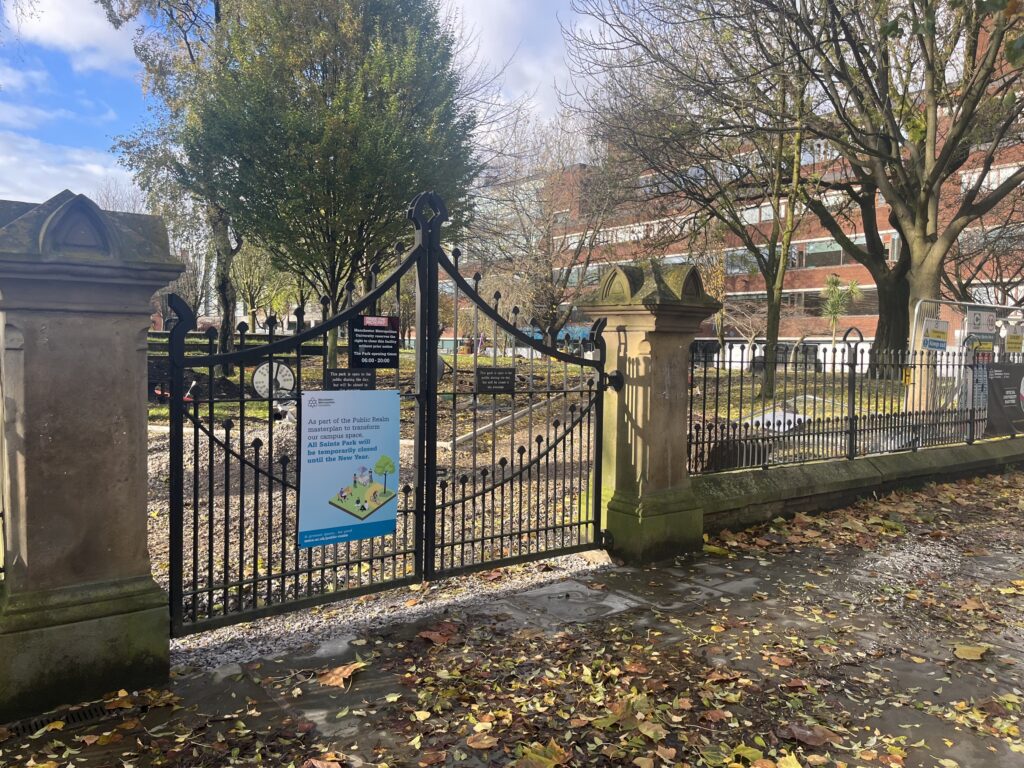Featured image: Ciara Reynolds
The headwinds of Storm Ciarán are coursing through Manchester. Big coats on. Hoods up. Only the most masochistic of ducks would consider this to be ‘nice weather’. Still, it’ll take more than a tempest to halt progress on the renovation of All Saints Park.
Heavy machinery is grafting hard as a handful of pigeons keep watch between haphazard pecks at the concrete. A dinky green digger is using its bucket to smooth down piles of aggregate along Lower Ormond Street. This transitional scene may finally make St. Augustine’s Church, that slab of brick-built brutalism to the rear of the park, feel less conspicuous.
Meanwhile, a JCB hauls a tonne or two of topsoil at a time from out of the guts of the park. The molehill of dirt soon grows into a twin-peaked mountain outside the Ormond Building. Another yellow digger scales its way to the summit, serving as makeshift security in case any passing climbers consider planting a flag.
The workers need to be careful, though. Just a few feet below that topsoil lie the remains of Mancunians past. 16,000 of them, jemmied into a graveyard the size of a couple of football pitches. In fact, make that 16,001.
“We did actually uncover some bones in an area we weren’t expecting to,” says Paul McCullough, Senior Project Manager of Manchester Met’s Capital Development Team.
The discovery began with a piece of bone, with an excavation revealing an entire skeleton. However, it wasn’t interred in a conventional plot, leaving the possibility that it could have been an unmarked pauper’s grave.
Archaeology professors from the University of Salford have a watching brief on the project, as they do with many digs around the area. If anything of interest comes up, they receive a call straight away. When you’re working around the dead, you need to be extra cautious.
“All the gravestones are under there,” McCullough continues. “When the former churchyard was turned into a park, it was created by putting fill on top. So, if you look at the park from the street, you’ll see that it rises quite significantly.
The only place there weren’t any graves was the original outline of All Saints Church. Everywhere else was full, and it was pretty much up to Oxford Road level.”
This means the diggers are hitting flattened gravestones at a depth of 500-700mm. There have also been unexpected finds within the church’s footprint, with the discovery of a burial chamber used by local dignitaries.
All Saints Church was consecrated in 1820 and predates the University and its most venerable buildings. It wasn’t all fields back then. Much of Manchester was slum.
Notorious areas like Little Ireland and Angel Meadows, whose squalid conditions inadvertently planted the seed of Marxism, sprung up between the city’s burgeoning cotton mills. Someone was getting rich, and it wasn’t those who lived in the tight warren of terraces. They were the mere human fuel of the Industrial Revolution.
Fanny Knowles was the first internee at All Saints. At 21-years-old, she wasn’t unduly young to meet her maker. Back then, the life expectancy of someone living in a British city was around thirty years. That’s assuming they made it past childhood. One-third of city kids didn’t reach their fifth birthday, and those that did were soon put to work, enduring twelve-hour shifts, six days per week, in the mills.
It’s no surprise that those 16,000 deaths accumulated in under forty years, when new burials stopped due to a lack of space.
So, what’s going on with All Saints Park today? Why has it closed all of a sudden?
“Basically, it’s getting much needed investment,” Paul says. “The park was last refurbished in the 90s. The council still owns it, but we’ve got a long lease. It’s unusual in that the university has responsibility for the park. Our security closes it at night and monitors it, but it’s still fundamentally a public space.
All Saints Park, being consecrated ground, is subject to certain restrictions that limit what Manchester Met can do with the land. For instance, it can’t host meetings or musical performances, and the sale or consumption of alcohol is also forbidden.
The developer, Casey, closed the park to the public on October 16th. This closure will remain until the new year.
Nevertheless, upon its anticipated completion in the spring of 2024, we can look forward to an array of new trees and wildflowers, more seating for those rare rainless days, and – with the exception of Oxford Road – pedestrianisation and improved cycle infrastructure on the streets bordering the park.
“We’ll have cycle stands on both streets,” McCullough says. “And the key cycle route will be maintained on Cavendish Street. The idea is that we’ll have a cycle-friendly campus.
“It’ll all be shared space, so there’ll be no kerbs except for decorative reasons. [There’ll be] improved accessibility, too, and that’ll gradually work its way across campus.”
The enhancement of All Saints represents Phase 1a of a wider scheme of on-campus improvements. Officially titled the Public Realm Masterplan, it anticipates linking up the main part of the university with the Brooks Building, although this potential development along Bonsall Street is years down the line. Before that, Phase 1b will renew the pedestrian area around the Geoffrey Manton and Grosvenor buildings, with Phase 1c connecting the earlier works along Higher Ormond Street.
“The Righton Building may be refurbished in the near future,” McCullough says. “So, it’d be natural to do that part of the public realm at the same time.”
Back outside, another sharp gust from Storm Ciarán enforces the annual autumnal shedding of leaves. The orange, yellow and brown confetti clogs drainage channels and settles on top of the flattened aggregate at the fringes of the park. A grey squirrel, bemused, dashes between contractors, perhaps looking for somewhere else to store its stash. Someone’s umbrella gives up. Winter is coming.
For more information about All Saints Park and other Manchester Met developments, visit mmu.ac.uk/public-realm






Leave a reply